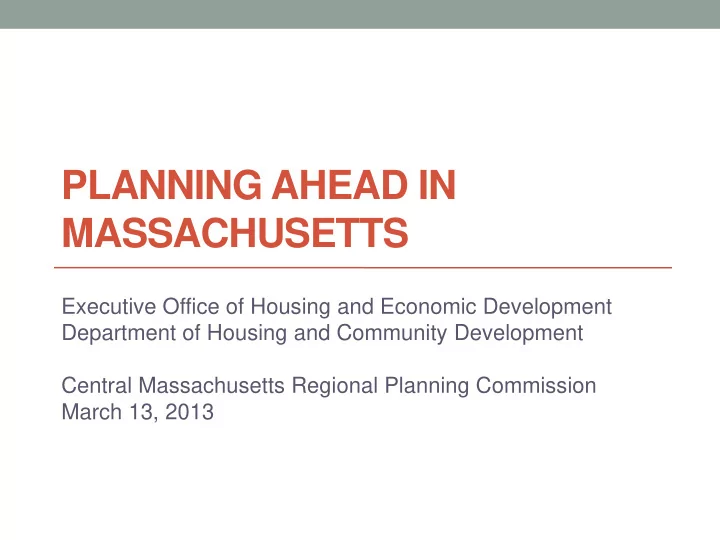

PLANNING AHEAD IN MASSACHUSETTS Executive Office of Housing and Economic Development Department of Housing and Community Development Central Massachusetts Regional Planning Commission March 13, 2013
Planning Ahead for Growth Planning ahead for job and housing growth is critical to our prosperity and to our quality of life. As a state, prior to 2007, we largely failed to plan ahead. Since 2007, we have been deliberately and consistently planning ahead.
The 4 Core Elements of Our Strategy Promising places for growth that have community support, are consistent with regional considerations 1 Identify and align with the Sustainable Development Principles Prompt and predictable zoning and permitting in 2 Create those places (both local and state) In public infrastructure needed to support growth 3 Invest To businesses and developers interested in locating 4 Market and growing in the Commonwealth
Economic Competitiveness in MA The Economic Development Plan Choosing to Compete in the 21 st Century 5 Categories, with 55 Actions Building Talent Innovation Economy Empowering Regions Ease of Doing Business Improving Cost Competitiveness 4
Statewide Housing Production Goal 10,000 multi-family units per year Reasonably dense, multi-family units Reasonably located, near employment opportunities and transit nodes Reasonably priced, for middle and moderate income families and individuals 5
Statewide Housing Production Goal A visionary plan to move the Commonwealth to a prosperous and healthy future: • Building 10,000 multi-family homes a year through 2020, particularly near transit, city/town centers and employment centers; • Shifting the way we travel, by tripling the share of travel by bicycling, transit and walking; • Reducing greenhouse gas emissions 25% from the 1990 levels by 2020.
Statewide Housing Production Goal Measurement Multi-family is defined as more than one unit • Performance will be measured on the multi-family permits pulled, statewide and • by community We will also track multi-family units planned, under construction or completed • near transit or commuter stops, in state priority areas (e.g., 40R and 43D districts) and within downtown and employment centers FOR DISCUSSION PURPOSES ONLY
Who will be making housing decisions? U.S. Age Cohorts 2010 Pre 1946 Boomer Gen X Gen Y
Households Counts 2010 vs. 2020 – “Current Trends” Projection Greater Boston (five counties)—from Barry Bluestone presentation at “Under One Roof ” Conference 11/13/12 Age in 2010 Number of Households in Number of Households in Change, 2010-2020 2010 2020 Age 2 5 -3 4 15-19 31,100 139,700 108,600 in 2 0 2 0 33,000 143,500 20-24 110,500 138,600 166,600 25-29 28,000 30-34 125,600 146,900 21,300 35-39 153,400 155,500 2,100 170,300 172,500 40-44 2,200 45-49 197,300 192,400 -4,900 50-54 186,900 182,700 -4,200 166,000 158,600 55-59 -7,400 60-64 145,600 129,200 -16,400 65-69 107,100 90,700 -16,400 77,600 53,400 70-74 -24,200 185,400 50,200 75+ -135,200 Grand Total 1,717,900 1,837,900 120,000
Shift in Housing Demand • Both Gen Y and Baby Boomers require more multi-family and fewer large-lot, single-family homes • Median household income in Greater Boston for householders under 25 down 31% since 2000 AND college debt for Massachusetts students up 66% • Aging baby boomers want to down-size and are careful about retirement costs
Will Central Mass build what is needed? Based on history, maybe not… UMass Donahue Center’s 2010 study for MHP projected: • About 28,000 units would be built by 2020 • Only 15% multi-family • Result: 18,000 more single-family homes than needed, with slight shortage of multi-family homes
Or maybe yes? Building Permit Survey, U.S. Census, Worcester County Annual Totals 3 and 4 Percenta Year Total 1 Unit 2 Units Units 5 Units or More 2+ units ge 2+ 2003 3,629 3,023 14 3 48 65 1.8% 2004 3,692 3,356 16 110 198 324 8.8% 2005 3,598 3,154 12 45 389 446 12.4% 2006 2,685 2,265 28 10 68 106 3.9% 2007 1,787 1,660 26 30 71 127 7.1% 15,391 1,068 6.9% 2008 909 803 64 59 297 420 46.2% 2009 1,419 973 102 142 200 444 31.3% 2010 1,391 1,067 38 133 165 336 24.2% 2011 791 726 78 113 48 239 30.2% 4,510 1,439 31.9% Columns H and I are not columns from Building Permit Survey, but data is from Survey
Haverhill, Downtown Three adjacent housing developments consisting of 500 new housing units. One of the three developments, the Hayes box factory is the redevelopment of two connected vacant mill buildings into 57 units of rental housing with ground floor commercial space The developments include various unit types, priced for a wide range of incomes, including one-third of the units priced for middle income households Various unit sizes and prices Transit Oriented Chapter 40R, designated in February 2007 14
Easton, North Easton Village Redevelopment of the Ames Shovel Works industrial building Mixed-use, with a new gallery, museum and open space 112 residential units Adaptive re-use of historic buildings Mixed-use 82 market rate units and 30 affordable units 15
Reading, Town Center The first development in Reading’s town center Chapter 40R district opened in October 2012. With 53 rental units, a restaurant and first floor retail, this development is located a block from the commuter rail station. Funding Sources: • Over $500K in Chapter 40R incentive and bonus payments • $200K committed by town for 11 affordable units.
Housing that Works in Action CORE ELEMENTS Identify Create Invest Market TOOLS Priority Chapter 43D Chapter 40B Planning Ahead Development for Growth Online Chapter 40R Chapter 40R Areas Mapping Tool District Local DHCD Housing Priority Mass.gov website Technical Assistance Preservation Assistance Areas Supporting MassWorks Best Practices for Stakeholders Infrastructure Model for Gateway Cities Streamlined Program Conferences and Local Permitting Compact Events Housing Neighborhoods Development 17 Incentive Program
Thank you Department of Housing and Community Development 100 Cambridge Street, Suite 300 Boston, MA 02114 617-573-1100 Larry Field Undersecretary’s office DHCD (617)573-1112 Laurence.Field@state.ma.us
Recommend
More recommend